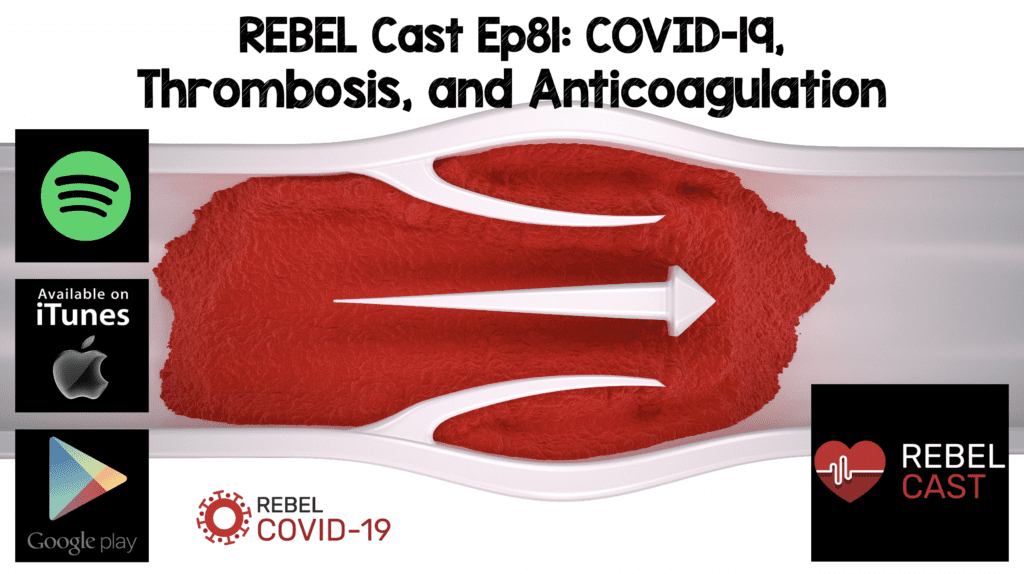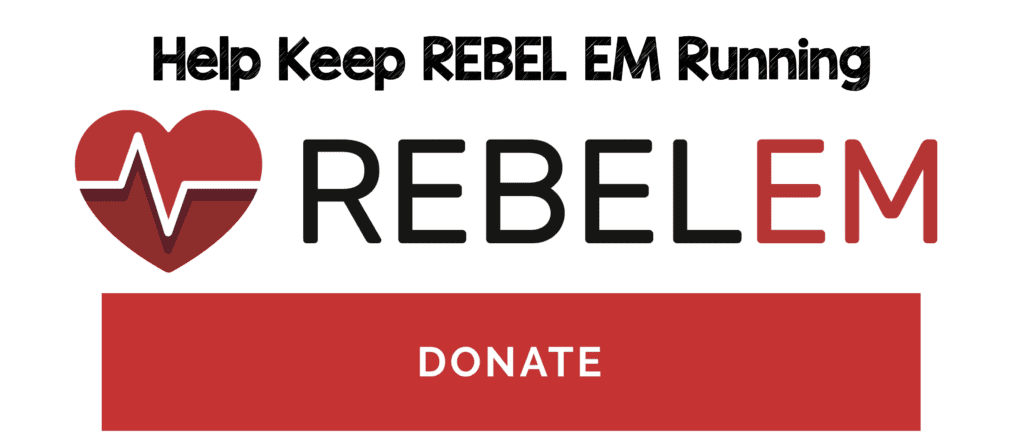
 Early reports have shown that COVID-19 is most likely causing a hypercoagulable state, however the prevalence of acute VTE and exactly how to treat it is an evolving area. Limited data suggest pulmonary microvascular thrombosis may play a role in progressive respiratory failure. However, most evidence is limited to small retrospective trials. As we wait for more evidence, clinical decisions have to made at the bedside and decisions about pharmacological prophylaxis are starting to emerge. In this episode I sit down with a special guest that is new to REBEL Cast to talk about the dilemmas involving COVID-19 and thrombosis.
Early reports have shown that COVID-19 is most likely causing a hypercoagulable state, however the prevalence of acute VTE and exactly how to treat it is an evolving area. Limited data suggest pulmonary microvascular thrombosis may play a role in progressive respiratory failure. However, most evidence is limited to small retrospective trials. As we wait for more evidence, clinical decisions have to made at the bedside and decisions about pharmacological prophylaxis are starting to emerge. In this episode I sit down with a special guest that is new to REBEL Cast to talk about the dilemmas involving COVID-19 and thrombosis.
REBEL Cast Episode 81 – COVID-19, Thrombosis, and Anticoagulation with Andrew Chernaik, MD
Click here for Direct Download of Podcast
Andrew Chernaik, MD

Andrew Chernaik, M.D.
Hospitalist, New West Physicians
Golden, Colorado
Education Undergraduate Education Arts and History – Tulane University, New Orleans Medical Education Doctor of Medicine – St. George’s University School of Medicine, Grenada, West Indies Residency Internal Medicine – Medical College of Pennsylvania, Philadelphia, PA Fellowship Intensive Care Registrar – St. Vincent’s Hospital, Melbourne, Australia
Twitter: @andrewchernaik
JACC just Published Recommendations on April 17th, 2020 [2]
-
Risk Stratification/In-Hospital Prophylaxis
- Prophylactic anticoagulation reduces the risk of VTE in hospitalized medical patients
- The choice of specific risk assessment models will vary across health systems
- Prophylactic daily LMWHs are recommended over twice daily subcutaneous unfractionated heparin (to reduce personal protective equipment use and exposure of staff)
- If pharmacological prophylaxis is contraindicated, mechanical VTE prophylaxis (intermittent pneumatic compression) should be considered in immobilized patients
-
Extended (Post-Discharge) VTE Prophylaxis
- Extended prophylaxis with LMWH or DOACs can reduce risk of VTE but comes with a risk of bleeding
- No data specific to COVID-19 exist, however it is reasonable to employ individualized risk stratification for thrombotic and hemorrhagic risk followed by consideration of extended prophylaxis (for up to 45d) for:
- Patients with elevated risk of VTE: Reduced mobility, co-morbidities such as active cancer, and elevated D-dimer>2x the upper limit who have low risk of bleeding
-
- Quarantined patients with mild COVID-19 but significant co-morbidities, or for patients without COVID-19 who are less active because of quarantine requires more study
- In absence of high-quality data, pharmacological prophylaxis should be reserved for those at highest risk of VTE (limited mobility, history of VTE, or active malignancy)
- Diagnosis of VTE
-
- Elevated D-dimer is a common finding in patients with CovID-19 and DOES NOT currently warrant routine investigation for acute VTE in absence of clinical manifestations or other supporting information
- Role for Empiric Therapeutic Anticoagulation Without a Diagnosis of VTE
- Some clinicians are using intermediate-dose or full dose therapeutic parenteral anticoagulation
- Existing data on this are very limited, primarily based on subgroup analyses
- The optimal dosing in patients with severe COVID-19 remains unknown
In-Patient Treatment:
- Any patient admitted with COVID-19 should be placed on prophylactic anticoagulation at a minimum
- Dosing for VTE prophylaxis:
- Lovenox (0.5mg/kg subQ daily) is better that the standard 40mg daily, especially in obese patients
- Utility of D-Dimer levels
- There is clear evidence showing that the higher the D-Dimer, the worse the outcomes. And patients who are dying are often found to have very high D-Dimer levels.1
- Can be used to determine who to admit, to monitor severity, and to guide anticoagulation therapy
- Admitting high-risk patients
- If D-Dimer > 3µg/L use therapeutic anticoagulation (TAC)
- Admitting low-risk patient
- If D-Dimer < 3µg/L use prophylactic dosing
- Admitting high-risk patients
Out-Patient Treatment:
- Initially we were thinking of COVID as primarily a pulmonary disease with a parenchymal etiology. But we are seeing more and more evidence for a vascular etiology as well and some critical care physicians have started using tPA in advanced COVID (Although this only lead to transient improvement in P/F ratios).
- Anecdotal findings: Earlier anticoagulation seems to be associated with better outcomes
- Area for study: Could we intervene even earlier in the course of the disease? For example, identifying at-risk populations who are COVID-positive and consider DVT prophylaxis (always weighing risks and benefits of course). My thinking is that this may improve hospital utilization and patient mortality.
- Guidelines for Extended post-discharge DVT prophylaxis:
- “After hospital discharge from acute medical illness, extended prophylaxis with LMWH or direct oral anticoagulants (DOACs) can reduce the risk of VTE, at the cost of increase in bleeding events, including major bleeding. While no data specific to COVID19 exist, it is reasonable to employ individualized risk stratification for thrombotic and hemorrhagic risk, followed by consideration of extended prophylaxis (for up to 45 days) for patients with elevated risk of VTE (e.g., reduced mobility, co-morbidities such as active cancer, and [according to some authors in the writing group], elevated D-dimer >2 times the upper normal limit) who have low risk of bleeding”2
- “The role of thromboprophylaxis for quarantined patients with mild COVID-19 but significant co-morbidities, or for patients without COVID-19 who are less active because of quarantine is uncertain. These patients should be advised to stay active at home. In the absence of high-quality data, pharmacological prophylaxis should be reserved for those at highest risk patients, including those with limited mobility and history of prior VTE or active malignancy.”2
- I’d add that patients with hypertension, diabetes and obesity should also be considered high-risk in the decision making process. And of course, remembering to consider D-Dimer as well.
- Providers have been uncomfortable with prescribing outpatient anticoagulation, understandably. Given the new JACC guidelines, I believe providers will be more comfortable using out-patient DVT prophylaxis, particularly in high-risk patients.
In the ED we don’t always have enough tests to confirm COVID-19 infection. Who should we place on anticoagulation upon discharge from the ED?
- Given the 70% sensitivity, I think it’s reasonable to use a clinical diagnosis:
- Symptoms consistent with COVID-19, lymphopenia, elevated D-Dimer, radiographic abnormalities consistent with COVID, and elevated CRP
- Weighing risk of bleeding vs risk of VTE
- HAS-BLED score for Major Bleeding Risk is what I use, but it’s a shared decision making strategy as usual
How long should patients be anticoagulated?
- Based on JACC Guidelines: Patients with moderate to severe disease who are discharged should be anticoagulated for up to 45 days
- I think 2 weeks or until symptoms are resolved is a reasonable starting place, but we really need more data
What medications should we use?
- Lovenox is reasonable (assuming creatinine clearance > 30mL/min)
- Dose: 0.5mg/kg subQ daily
- DOACs
- Eg: Eliquis 2.5mg po bid
- Don’t use Coumadin
- INR is unreliable and impractical in the current setting
Need for follow-up?
- Close follow-up is ideal
- I think it would be ideal to follow D-Dimers and adjust anticoagulation appropriately. More research is needed here as well.
- Can even use telehealth with PCPs but definitely should not discharge patients on anticoagulation without follow-up
I have a patient in the ED who meets my clinical diagnosis of COVID, I get a D-Dimer and I am ready to discharge them. How are you using D-Dimers to decide what dose of anticoagulant to start people on?
- Patients with an abnormal, age-adjusted D-Dimer < 1.5µg/L, but meet discharge criteria, should be considered for outpatient prophylaxis
- If D-Dimer > 1.5µg/L, patient should be considered for admission
- If you’re in the gray-area and/or the patient has co-morbid conditions that put them at risk, it’s reasonable to consider DVT prophylaxis (Lovenox 0.5mg/kg subQ daily)
- Based on JACC guidelines: Elevated D-Dimer is a common finding in COVID patients, but it does not warrant any further investigation in the absence of any clinical manifestations. No need to go chasing after VTE.
I have a COVID-19 patient I am sending home with anticoagulation. How are you educating these patients upon discharge?
- I think risk of thrombotic events has been underemphasized in the public eye, so it is very important for providers to educate patients upon discharge
- There is a wide range of possible manifestations of microthrombi:
- Skin rashes, sudden abdominal pain, stroke-like symptoms, chest pain, etc.
- Of course we should still be having the usual discussion about increased risk for bleeding with anticoagulation
Putting it All Together:
- Premises
- We have a documented coagulopathy associated with COVID
- We have significant anecdotal evidence that earlier aggressive anticoagulation is having a positive effect on outcomes
- We have used DVT prophylaxis in other conditions where patients were thought to be at increased risk. Ex: following orthopedic surgeries
- We will likely have to wait 2-3 months to see any RCT results on this, meanwhile being in the middle of a pandemic.
- Conclusion: It is reasonable to consider DVT prophylaxis for patients that providers feel are at higher risk for developing the severe form of COVID. And this is in complete agreement with JACC guidelines.
Take-Home Message:
- Though the details of what medication and how long will likely be institution-specific, it is important that we all consider anticoagulation upon discharge for high-risk COVID-19 patients.
For More on This Topic Checkout:
- REBEL EM: COVID-19 – Thrombosis & Hemoglobin
References:
- Zhang L et al. D-dimer levels on admission to predict in-hospital mortality in patients with Covid-19. J Thromb Haemost 2020. PMID: 32306492
- Bikdeli B et al. COVID-19 and Thrombotic or Thromboembolic Disease: Implications for Prevention, Antithrombotic Therapy, and Follow-up. J Am Coll Cardiol 2020. PMID: 32311448
Transcript By: Yasien Eltigani, MS4 at St. George’s University (@yasieneltigani)
Post Peer Reviewed By: Anand Swaminathan, MD (Twitter: @EMSwami)
The post REBEL Cast Ep81: COVID-19, Thrombosis, and Anticoagulation appeared first on REBEL EM - Emergency Medicine Blog.

